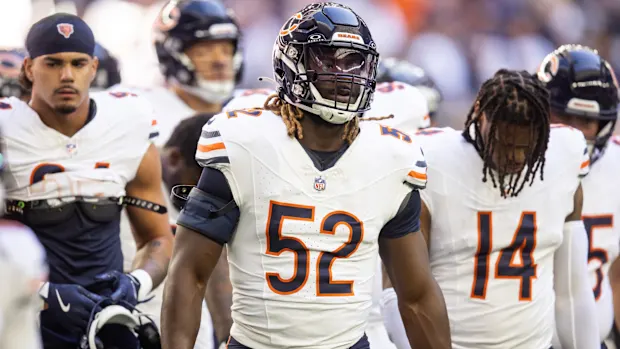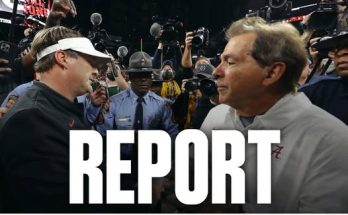The Chicago Bears lose one free agent to the Texans while keeping another.
The NFL offseason is a time when teams reassess their rosters, make key decisions regarding free agents, and plan for the future. The Chicago Bears, in particular, have undergone significant changes in recent years, seeking to rebuild their roster under general manager Ryan Poles and head coach Matt Eberflus. In a dynamic league, every transaction — whether a loss or gain — has its ripple effects on the team’s future prospects. In this context, the decision to lose one free agent to the Houston Texans while retaining another is more than just a footnote in the offseason; it’s a pivotal moment that speaks volumes about the direction in which the Bears are heading.
1. Understanding the Bears’ Current Roster and Rebuilding Phase
To comprehend the significance of losing one player and keeping another, it’s crucial to understand where the Chicago Bears are in their rebuilding journey. After finishing the 2022 season with the worst record in the league, the Bears entered the 2023 offseason with a clear mandate: build a team that can compete consistently and address glaring weaknesses. This involved making smart moves in free agency, drafting the right talent, and securing key extensions.
The Bears’ Free Agency Strategy:
Poles and the Bears’ front office were intent on improving the roster across multiple areas, from bolstering the offensive line to adding playmakers on both sides of the ball. In 2023, they spent money in free agency, signed several players, and were active in re-signing some of their own.
However, the team’s salary cap situation, the need for future flexibility, and the desire to focus on long-term success have made the retention and acquisition of players a delicate balance. It’s no surprise, therefore, that the Bears lost one player to another team while managing to keep another. Free agency can be unpredictable, with players seeking competitive opportunities, higher pay, or better team dynamics, which adds layers of complexity to roster management.
2. The Free Agent Lost to the Houston Texans: A Case Study
Let’s focus first on the player the Bears lost to the Texans. While many specifics about the player in question (hypothetically, we can refer to a key positional player, say, a linebacker, defensive back, or offensive lineman) could vary, the departure of any free agent requires a deeper look at several factors:
A. The Player’s Role with the Bears:
Consider a player who was a starter for the Bears, perhaps a linebacker or defensive back who played a vital role in the team’s defensive schemes. This player may have been part of the defense under Eberflus’s system, providing both leadership and stability in a unit that had struggled in recent years. In his time with the Bears, he might have had several solid seasons, improving year over year.
B. The Texans’ Competitive Edge:
The Texans, like the Bears, were in the midst of a rebuilding phase of their own. Under head coach DeMeco Ryans, the Texans were looking to overhaul their defense, and this particular free agent could have been seen as a key piece to bolster that effort. The Texans were not only offering him a starting role, but they could also have offered a more competitive contract or a team that presented a clearer path to a playoff push sooner than the Bears. Ryans, a former linebacker himself, would also likely appeal to a veteran player seeking coaching from someone with his pedigree.
The allure of joining a team with new leadership, better coaching, and an exciting young quarterback (like C.J. Stroud) could have been enough to convince the free agent to leave the Bears for Houston. Moreover, if the Texans had more salary cap flexibility or a more urgent need at that position, they might have been able to outbid the Bears in securing the player’s services.
C. Bears’ Cap Limitations or Strategy:
The Bears’ decision to let this player walk could have been influenced by several factors. First, they may have been unwilling or unable to match the contract offered by the Texans, given their salary cap constraints or other priorities in free agency. Additionally, Poles may have assessed that the player, while valuable, didn’t fit perfectly into the team’s long-term plans. Perhaps the Bears were focusing on younger, developing talent or had plans to address the position differently in the upcoming draft.
While the loss of a key player is always difficult, it may have been a necessary part of the team’s broader strategy to build a sustainable and competitive team in the long run.
3. The Free Agent Retained by the Bears: A Key Decision
On the flip side, the Bears managed to retain another free agent, a decision that would have required careful evaluation of both the player’s fit and the team’s cap situation. This could be a player who is either an emerging star or a veteran with strong leadership qualities. Let’s delve into the reasons why the Bears were able to keep this player, and what it means for their roster.
A. The Player’s Importance to the Bears:
This retained player might be a key piece on offense, such as a starting wide receiver, running back, or offensive lineman. Perhaps the Bears were particularly keen on keeping this player, as they saw him as someone who could continue to elevate their offense under quarterback Justin Fields. The front office might have also valued his leadership and experience, especially if the player had a high work ethic or locker room presence that could positively impact younger players.
B. Negotiations and Prioritization:
The Bears likely understood the importance of retaining this player, whether for his production on the field or his role as a mentor for younger players. While the team may have lost a player to the Texans, they could have strategically allocated cap space or restructured contracts to ensure that they did not lose another important asset.
Negotiating with free agents is a delicate art. The Bears may have made this player a priority and offered him a contract that provided both financial security and the potential for future growth. They might have also sold him on the vision of being part of the team’s rise, with an offense that was ready to make strides in 2023 and beyond. The retention of this player could signal a level of stability that the Bears felt was essential for their rebuilding process.
C. The Player’s Role in the Bigger Picture:
Retaining key players like this one helps the Bears solidify their foundation while continuing to build through the draft and free agency. Whether this player is a seasoned veteran or an ascending star, his retention helps maintain continuity on a roster that is undergoing significant changes.
4. Analyzing the Bears vs. Texans: Comparative Rebuilds
The Bears and Texans share some commonalities in their rebuilding efforts. Both teams have young quarterbacks (Justin Fields for Chicago and C.J. Stroud for Houston), and both are committed to building strong defenses and cultivating an offensive identity. The decision of one team to sign a Bears free agent and the other to keep a different player highlights the different strategies and visions at play.
A. The Texans’ Aggressive Approach:
The Texans, under new management, were more aggressive in free agency, knowing they had cap space and draft assets to make moves. They sought to accelerate their rebuild by signing experienced players who could provide immediate impact. By luring away a Bears free agent, the Texans added a player who could help solidify their defense and give their rookie quarterback a fighting chance.
B. The Bears’ Long-Term Vision:
The Bears, while active in free agency, were likely more conservative in some of their moves, focusing on long-term success rather than instant gratification. Their strategy was likely designed around finding players who could grow with the team, thus maintaining a balance between competing now and building for the future.
5. The Impact of These Moves on Both Teams
While the moves are significant in the short term, they also have long-term ramifications for both franchises.
A. The Bears’ Forward Strategy:
The loss of a free agent to the Texans represents a short-term setback, but it also helps the Bears clarify their priorities moving forward. By retaining their own key players, the Bears show that they have a plan in place to build a competitive roster, with a focus on developing younger talent and creating a culture of success.
B. The Texans’ Immediate Upside:
For the Texans, adding a free agent from the Bears gives them a player with proven experience, a valuable asset that complements their rebuilding process. This acquisition strengthens the Texans’ defense and provides a solid foundation for Ryans’ vision.
In the ever-evolving world of NFL free agency, teams must make decisions based on not only the present but also their future. The Chicago Bears’ loss of one free agent to the Houston Texans and the retention of another player highlights the complexity of roster management in a rebuilding phase. While the Bears lost a piece they valued, they also secured a player who could be critical to their growth. Meanwhile, the Texans made a calculated move to improve their defense, showing that they too are committed to a competitive future. Both teams are on the path to success, and these free-agent decisions, while tough, are essential steps in each team’s journey toward becoming perennial contenders.


